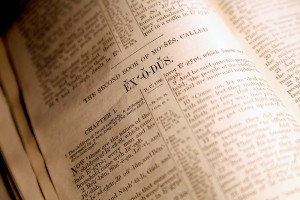Exodus (Shemot) is the book whose principle theme is redemption—Israel’s deliverance from Egypt (Mitzraim). Here we learn how YHVH saves his people and we are shown that his people are redeemed in order to worship him.
The Theme of Redemption
Say, therefore, to the sons of Israel, “I am YHVH, and I will bring you out from under the burdens of the Egyptians, and I will deliver you from their bondage. I will also redeem you with an outstretched arm and with great judgments. Then I will take you for My people, and I will be your Elohim; and you shall know that I am YHVH your Elohim, who brought you out from under the burdens of the Egyptians. I will bring you to the land which I swore to give to Abraham, Isaac, and Jacob, and I will give it to you for a possession; I am YHVH.” (Exod 6:6-8, emphasis added)
Worship
And he said, “Certainly I will be with you, and this shall be a token unto you, that I have sent you, when you have brought forth the people out of Egypt, you shall serve Elohim upon this mountain.” (Exod 3:12, emphasis added)
And I say unto you, “Let my son go, that he may serve [Hebr. awvawd, Strong’s H5647] me, and if you refuse to let him go, behold, I will slay your son, even your firstborn.” (Exod 4:23, emphasis added)
And you shall say unto him, “YHVH Elohim of the Hebrews has sent me to you, saying, ‘Let my people go, that they may serve [Hebr. awvawd, Strong’s H5647] me in the wilderness, and, behold, until now you would not hear.’” (Exod 7:16, emphasis added)
The Basic Outline of Exodus
Chapters 1–6 show us the need for redemption.
Chapters 7–11 show us the power or might of the Redeemer as the ten plagues are poured out upon Egypt.
Chapters 12–18 show us the character of redemption; purchased by blood and emancipated by power.
Chapters 19–24 we are taught the duty of the redeemed.
Chapters 25–40 we see the restoration of the redeemed—provisions are made for the failures of the redeemed.
The Metaphors in Exodus
Egypt is a metaphor for the world, the place of sin and bondage where one is held captive before being delivered or redeemed by the power of YHVH and the blood of Yeshua, the Lamb of Elohim. It is interesting to note that although Egypt was the land of science and art, it was similarly the land of death. Their religion was fixated with death.
Pharaoh is a metaphor for Satan, a merciless taskmaster who opposes the people of YHVH every step of the way.
Pharaoh’s magicians is a metaphor for demonic spirits, doing Pharaoh’s bidding in opposing Israel.
Moses is a prophetic metaphor for Yeshua (his first coming), the Deliverer of his people from the bondage and power of sin, death and hell, which is the power of the enemy, Satan.
The blood of the lamb on the door posts is a metaphor for Yeshua, the Redeemer, whose death on the cross atoned for man’s sins causing YHVH’s judgment against sin to passover us.
The crossing of the Red Sea is a metaphor for our union with Messiah Yeshua in his death and resurrection via the ritual of tevilah (immersion or baptism) at a mikvah (a gathering of waters).
The journey through the wilderness is a metaphor for the trials and testing that occur during the redeemed believer’s spiritual walk through this life with YHVH’s provision to meet every need and his protection from every attack of the adversary.

The giving of the Torah is a metaphor for the obedience and submission that we owe to YHVH, our new Master.
The Tabernacle of Moses with its furnishings is a metaphor for YHVH’s plan of redemption (salvation) for mankind and the steps in man’s spiritual maturation into intimacy with the Father through Yeshua the Messiah.





